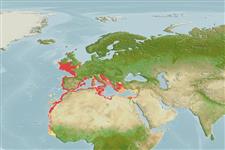Elasmobranchii (tubarões e raias) (sharks and rays) >
Rajiformes (Skates and rays) >
Rajidae (Skates)
Etymology: Raja: Latin, raja, -ae = a sting ray (Raja sp.) (Ref. 45335).
More on author: Lacepède.
Environment: milieu / climate zone / depth range / distribution range
Ecologia
marinhas demersal; intervalo de profundidade 50 - 200 m (Ref. 6808). Subtropical; 53°N - 9°N, 19°W - 36°E
Eastern Atlantic: southern Ireland and England to Senegal, including the western Mediterranean and the Canary Islands. Reported from the eastern Mediterranean (Ref. 3261).
Length at first maturity / Tamanho / Peso / Idade
Maturity: Lm 80.0 range ? - 85.2 cm
Max length : 100.0 cm TL macho/indeterminado; (Ref. 4426)
Found on sandy bottoms of shelf waters (Ref. 3167). Feed on all kinds of bottom animals (Ref. 3167). Oviparous. Distinct pairing with embrace. Young may tend to follow large objects, such as their mother (Ref. 205). Eggs are oblong capsules with stiff pointed horns at the corners deposited in sandy or muddy flats (Ref. 205). Egg capsules are 7.2-9.0 cm long and 4.2-5.2 cm wide (Ref. 41303 , 41251, 41304).
Life cycle and mating behavior
Maturidade | Reprodução | Desova | Ovos | Fecundidade | Larvas
Oviparous, paired eggs are laid. Embryos feed solely on yolk (Ref. 50449). Egg-cases laid from March to September (Ref. 3167). Distinct pairing with embrace. Young may tend to follow large objects, such as their mother (Ref. 205).
McEachran, J.D. and K.A. Dunn, 1998. Phylogenetic analysis of skates, a morphologically conservative clade of elasmobranchs (Chondrichthyes: Rajidae). Copeia 1998(2):271-290. (Ref. 27314)
Categoria na Lista Vermelha da IUCN (Ref. 130435: Version 2024-2)
Ameaça para o homem
Harmless
Utilização humana
Pescarias: espécies comerciais; peixe desportivo: sim
Ferramentas
Relatórios especiais
Descarregue XML
Fontes da internet
Estimates based on models
Preferred temperature (Ref.
123201): 9.8 - 17.1, mean 13.2 °C (based on 157 cells).
Phylogenetic diversity index (Ref.
82804): PD
50 = 0.5000 [Uniqueness, from 0.5 = low to 2.0 = high].
Bayesian length-weight: a=0.00302 (0.00194 - 0.00469), b=3.19 (3.07 - 3.31), in cm total length, based on LWR estimates for this species & Genus-body shape (Ref.
93245).
Nível Trófico (Ref.
69278): 3.5 ±0.37 se; based on food items.
Resiliência (Ref.
120179): Baixo, tempo mínimo de duplicação da população 4,5 - 14 anos (Fec assumed to be <100).
Fishing Vulnerability (Ref.
59153): High to very high vulnerability (66 of 100).
Climate Vulnerability (Ref.
125649): Moderate vulnerability (38 of 100).
Nutrients (Ref.
124155): Calcium = 11.4 [1.5, 220.4] mg/100g; Iron = 0.693 [0.064, 8.306] mg/100g; Protein = 17.2 [14.4, 19.5] %; Omega3 = 0.486 [0.222, 1.080] g/100g; Selenium = 28.1 [5.6, 137.4] μg/100g; VitaminA = 4.78 [0.40, 50.57] μg/100g; Zinc = 0.511 [0.033, 5.798] mg/100g (wet weight);
